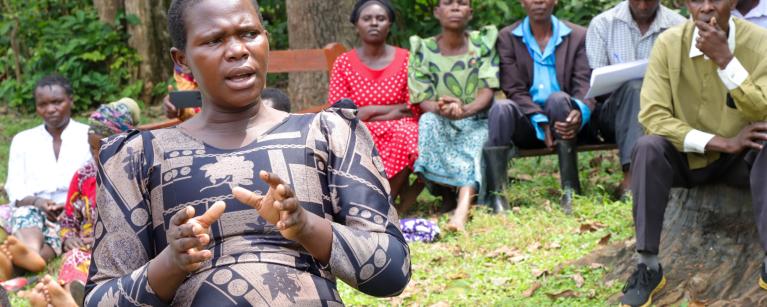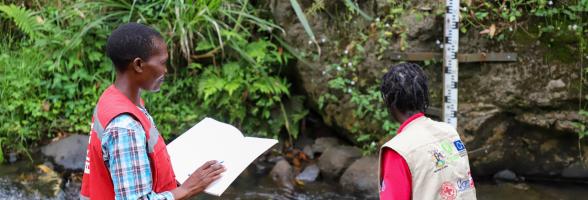Communities are not only victims but are the first responders when disasters strike. They are the first to evacuate and house the victims, identify the hot spots, and often use their indigenous knowledge to detect, prepare and respond to disasters.
In the Mt Elgon region, community structures are at the helm of de-risking the disasters. Mt Elgon is one of the regions prone to disasters such as landslides, mudslides, and floods, which destroy property, lives, and livelihoods, leaving the communities devastated.
As Jane Nadundu – a mother of 8 from Nakisikilo, Buluganya, in Bulambuli district, narrates, the landslides left their village in a dilapidated state.
“We had grown coffee, matooke, cocoyam and beans. Everything was submerged, and we did not harvest anything. It also destroyed the households of our relatives who currently have nowhere to go. We are now staying with three of them. This has increased the burden and cost of living like food and shelter”
Thanks to the European Union Civil Protection and Humanitarian Aid Operation (ECHO)- funded Strengthening Community-led and locally owned Disaster Preparedness Actions. Interventions were designed to strengthen community-led and locally-owned disaster preparedness actions to ensure local communities prepare and respond to disasters.
Through a consortium of Oxfam, Uganda Red Cross Society, Catholic Relief Services, and Caritas Uganda, the communities across the 5 districts where the project operates have been trained on disaster preparedness and response practices such as anticipatory actions, commonly known as early actions, disaster risk reduction activities, and communication. As a result, the communities have stepped up to respond and take up adaptation measures.
Anticipatory actions, commonly known as early actions are implemented when the disaster has been predicated to prevent loss. Activities include clearing drainage channels, digging trenches to clear water passage, constructing contours and rehabilitating footbridges.
While these have been implemented in disaster-stricken areas, most households have adopted the practices, including those unaffected by previous disasters.
‘’The landslides affected my neighbours, who are one and a half kilometres away; I realized I am also at risk. I have made contours in the gardens to trap water from flowing down. We also use water in our gardens and the collected soil as manure,” Fred Wakube, 42, Chairperson, Marobo in Bududa District, said.
Fred also plants crops on contours to control soil erosion and hold the speed of water flow. He has also planted trees.
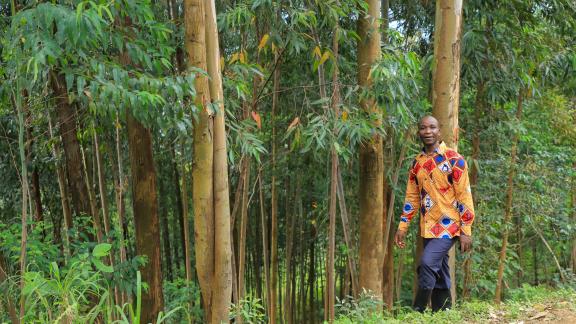
Fred Wakhube - Chairperson of Marobo Village in Bududa District. Fred has put in practice the skills they received from the training on mitigating disasters such as digging, trenches and planting trees. He has made an effort to plant trees and sensitise the communities. Photo By Ivan Rackara | Oxfam in Uganda
The village disaster management committee members, such as Fred, were provided with tools such as hoes, rakes, gum boots, wheelbarrows, pangas, and sacks for sandbagging, which have been used in delivering such actions. Although this work is voluntary, the community members who were engaged in digging contours and opening trenches through a cash-for-work arrangement received a one-off facilitation of UGX100,000 for ten days work.
The committee members do not work alone. They are supported by the Red Cross Action team and Caritas and Catholic Relief Services field teams across the five districts.
“We sensitize communities and conduct capacity-building training on safeguarding, gender and inclusiveness, village mapping, and referrals. We also advised them during the formation of village DMCs to further cascade and sensitize communities, especially in risky areas, on safer ways of responding to disasters,” Susan Kimono, Project Officer at Caritas Uganda, noted.
As a result, Nagudi Jennifer, a member of Bukuna DMC, shared that; “we can now work with men and participate in the community activities, which was not very common before.” This has strengthened the relationships of women and men in communities.
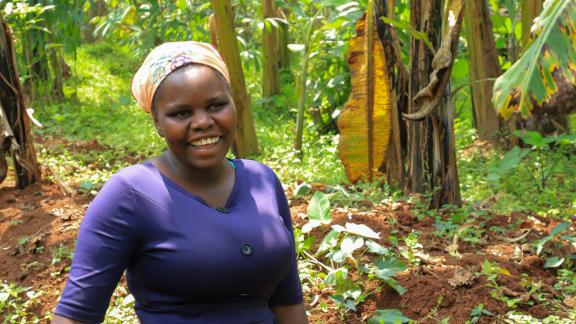
Barbrah Khabuya is a member of Bulucheke Village Disaster Management Committee in Bududa District. She was appointed to monitor cash-for-work program. She also received 100,000UGX for this supervisory role which she’s well qualified for having attained a diploma in crop husbandry. She used the money to buy food and used the remaining money to treat the cow. She grows bananas and beans, with a supplementary kitchen garden. She gets her income from selling milk. Photo By Ivan Rackara | Oxfam in Uganda
Another training is the enhanced vulnerability capacity assessment (eVCA) training, where communities have been trained on identifying risk areas / hot spots that could result in disasters. Here, they were guided in identifying the best possible actions to solve the problem. eVCA has been conducted in 10 sub-counties, while 100 villages were selected for anticipatory actions.
‘’We train the communities to draw maps, showing the villages, sub-counties, hot spots, the evacuation centers, the safe areas, and the people who live in hotspots and their livelihood. This helps us to know the people who have been affected in case the disaster strikes, even before we come to do the assessment,’’ Brenda Atero – Emergency Preparedness & Response Assistant Officer at URCS.
The training made it evident to the communities that their actions would significantly contribute to disaster reduction.
‘’We were well informed that in disaster situations, the community has a role in mitigating the disasters. Some of these things, we knew but had no commitment. Now, we join hands and work together. We don’t mind about getting a salary, we don’t want to see people in our communities suffering. We are motivated for the good of our community,” Sam Kibosi, Chairperson of a 10-member Nambiti B Village Disaster Management Committee, stressed.
“When the community members are sitting and planning for disaster issues in their respective areas and come up with action plans, they forward them to the subcounty, which are some of the issues and plans we discuss in the District Disaster Management Committees (DDMCs) because we don’t have our own issues as DDMCs. The sub-county chiefs and the community development officers are always invited to make presentations during the DDMC meetings. During these meetings, we capture the actions that have come from the subcounty level, from the villages up to the district”
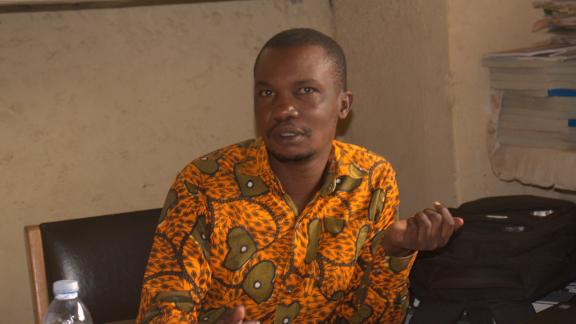
Patrick Kibet, Senior Probation Officer for Bududa District. He also doubles as the secretary to DDMC. Patrick added that when the disaster strikes, the DDMC rely on people to get information which helps them to plan and act faster. The community members identify the risky areas and inform the DDMC to respond and notify risky households to vacate. Photo By Sarah Mazirwe | Oxfam in Uganda
Immediately after receiving training, the village disaster management committees across the implementation districts embarked on developing their action plans. Among the plans was sensitizing the communities on measures to plan ahead of the floods to minimize damage.
The village action plans are crucial as the issues identified inform sub-county action plans and discussions during sub-county disaster management meetings. Currently, 100 village action plans have been developed. The action plans are equally adopted by sub-counties to lobby at the district.
At the District level, the consortium has trained and supported the development of the District Contingency plans (DCPs) in five districts of Mbale, Bududa, Sironko, Butaleja, and Namisindwa. These are planned to cover over 80,000 people. The contingency plans are critical as they comprehensively analyze hazard risk, vulnerability, capacities, and resources necessary for disaster preparedness and response.
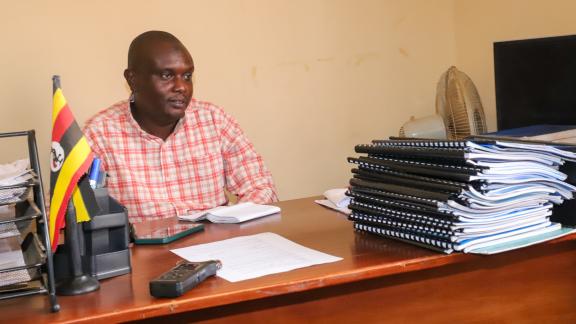
Ismail Wakhaiza is the sub-county Chief of Bungokho S.C – Mbale District. He noted that the training on disaster and response has empowered the communities to report cases of poor practices of land usage. The communities are now aware of disasters and how to deal with them. Bungokho sub-county from the training was able to develop sub-county action plans, which are being used to lobby from the district to tackle disasters. Photo By Ivan Rackara | Oxfam in Uganda
So far, the contingency plans for the Bududa, Butaleja, and Mbale districts have been completed.
“If all sub-counties have their plans, the districts develop their contingency plans, it will be critical in planning and responding to disasters timely,’’ Ismael Wakhaiza, the sub-county chief of Bungokho in Mbale District, noted.
As Patrick Kibet notes, “Good planning is bottom-up from the village level to the district level.”
Strengthening and empowering communities enables them to find applicable and sustainable solutions in disaster risk management.
By Sarah Mazirwe - Communications Assistant (Oxfam in Uganda)
